This from Dennis McGuire, Jr.:
Found this on Facebook: X-Waukegan, Illinois now sitting in a field in Pennsylvania.

found on Facebook

found on Facebook

found on Facebook
and from our files:
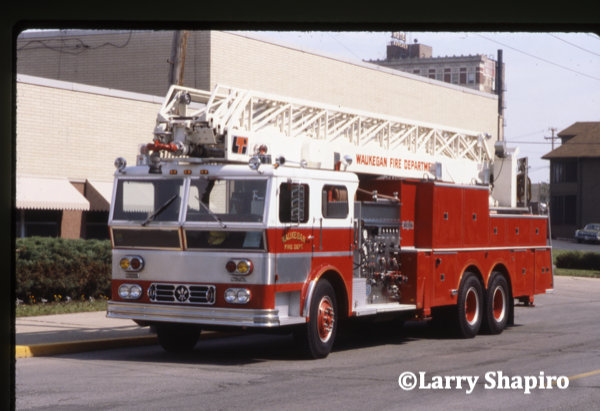
Larry Shapiro photo

Larry Shapiro photo
Oct 3
Posted by Admin in Fire Department History, Fire Truck photos, Historic fire apparatus | 7 Comments
This from Dennis McGuire, Jr.:
Found this on Facebook: X-Waukegan, Illinois now sitting in a field in Pennsylvania.

found on Facebook

found on Facebook

found on Facebook
and from our files:

Larry Shapiro photo

Larry Shapiro photo
Tags: #larryshapiro, chicagoareafire.com, Larry Shapiro, larryshapiro.tumblr.com, larryshapiroblog.com, shapirophotography.net, vintage Ward LaFrance / LTI aerial, Ward LaFrance Ambassador, Waukegan FD Truck 1631, Waukegan Fire Department history
May 11
Posted by Admin in Fire Department History, Historic fire apparatus | 3 Comments
This from Danny Nelms:
Was posted on Facebook by Sam Guners
“Saw this in central pa south of roaring spring on rt 36 @ 868Nobody around to ask about it – Painted over name looks like Waukegan”
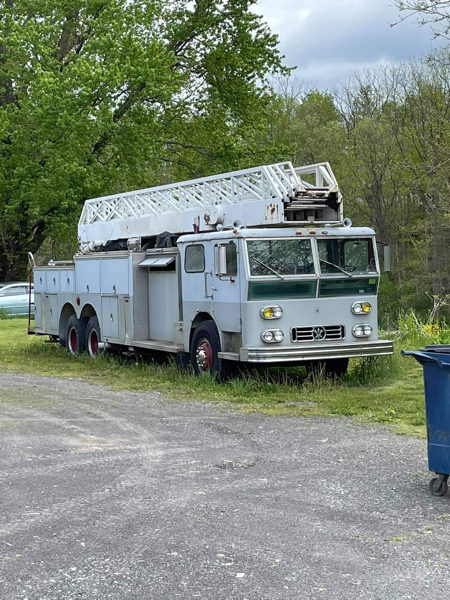
Sam Guners photo
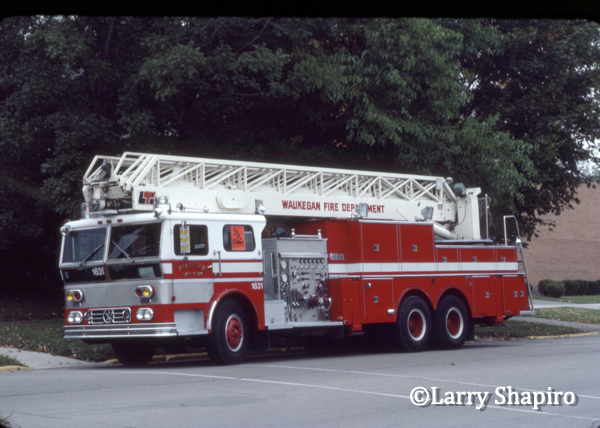
Larry Shapiro photo
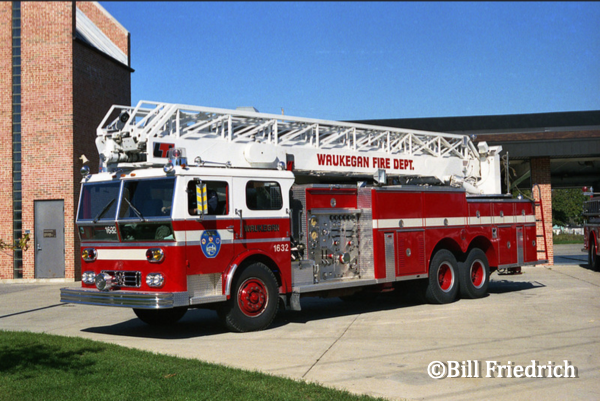
Bill Friedrich photo
Tags: #larryshapiro, Bill Friedrich, former Waukegan fire Turks in Pennsylvania, Larry Shapiro, larryshapiro.tumblr.com, larryshapiroblog.com, old Ward LaFrance LTI aerial found in PA, shapirophotography.net, vintage Ward LaFrance / LTI aerial, Waukegan Fire Department history
Dec 11
Posted by Admin in Fire Department History, Historic fire apparatus | 5 Comments
The final installment in the Waukegan Fire Department history series includes these images supplied by the fire department.
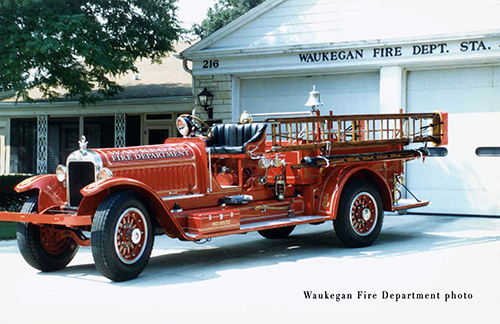
1921 Stutz. Waukegan Fire Department photo

Waukegan Fire Department photo
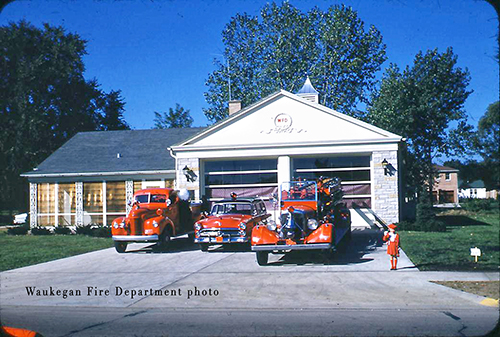
Waukegan Fire Department photo
We are grateful to the Waukegan Fire Department for sharing their history with us.
Tags: historic fire photos, historic fire truck pictures, Waukegan Fire Department, Waukegan Fire Department history
Dec 10
Posted by Admin in Fire Department History | Comments off
Part 3 of the Waukegan Fire Department history, courtesy of the Waukegan Fire Department.
1930’s and 1940’s
The 1930’s and 1940’s brought new challenges to the Waukegan Fire Department as Waukegan struggled first with the economic difficulties of the Depression and later saw its resources challenged during wartime. Despite these difficulties, the department continued to be an innovator. In 1935, the Waukegan Fire Department pioneered inhalator-resuscitator work in addition to traditional fire service duties. On June 26, 1936, the firemen joined the International Association of Firefighters and were issued the charter as IAFF Local 473.
Another serious fire occurred on December 16, 1943 that destroyed a portion of the east side of the one hundred block of North Genesee Street. Later, the Hein’s Store would be built on this site.
1950’s and 1960’s
The post war boom brought new growth to Waukegan and the fire department. On September 28, 1952, Mayor Robert E. Coulson, Chief Norman Litz and the council dedicated the West Side Fire Station located at 216 N. Lewis Ave. An estimated 3,000 people attended the event. Also dedicated was a new $16,000 Seagrave pumper. Later that year, on October 5, 1952, Chief Litz unveiled the city’s new Seagrave 85-foot aerial ladder truck, which was purchased at a price of $37,000.
The Central station was remodeled again in 1954. Four years later, the building was deemed obsolete in due to space restrictions and hazardous in its location of fire lines that ran through the congested streets of the business district. In 1962, the Central Fire Station moved from Madison Avenue to the city hall with facilities that faced West Street.
In June of 1955, the Old Clock Tower at the Courthouse burned. Shortly thereafter, a fire prevention ordinance established a dedicated fire prevention bureau for the department. In 1958, the Nitro Chemical Plant located at 740 Market Street was gutted by fire. Waukegan firemen fought the fire in brutally cold conditions. It took almost 11 hours to gain control of the stubborn fire.
Three captains, 11 lieutenants, one master mechanic, and 46 firemen staffed the Waukegan Fire Department, in 1959. The department’s rolling equipment included two rescue squad cars, an emergency truck, four pumpers, one 85-foot aerial truck, one 65-foot aerial truck, and the chief’s car. Firemen were on duty 56 hours a week and responded to approximately 600 calls that year. The Illinois Bell Telephone Company transmitted fire alarms through its attended machine-switching central offices in its fireproof central offices in Waukegan’s business district.
In 1960, a fire at the Johns Manville plant caused an estimated $6 million in damage. Other notable fires of that decade include the Commercial Hotel Fire in 1965, two fires at the Piggly Wiggly Store in 1964 and 1965, and the Sahs Warehouse Fire in 1966.
In 1966, the department responded to 1,530 calls with approximately the same number of firemen and equipment as seven years earlier. As the city grew, so did its fire department. In 1969, the North Side Fire Station was constructed at the corner of Golf Road and Jackson Street. In that same year, the Waukegan Tannery was rocked by an explosion and tremendous fire necessitating all available apparatus and manpower.
1970’s
In 1972, Lt. Dale Adams established the Waukegan Fire Department Bomb Team under the direction of Fire Commissioner Edward R. Pavelick. Initial training for the new team was conducted by the New York Police Department and later through the FBI at the Redstone Arsenal in Huntsville, Alabama.
Commissioner Pavelick also established and introduced the first EMT-Paramedic program to protect the citizens of Waukegan during medical emergencies. The WFD was the second public safety agency in the state to offer this service. Waukegan’s new EMT’s were graduates of the first paramedic training class offered in Illinois.
In 1979, an unprecedented number of members retired from the department including Joseph Regis, Lt. John Kink, Richard Repp, Charles Ahlstrom, James Poirier, Sgt. Charles Dicig, Sgt. William Worth, Lt. Roy Hampson, Lt. James Hushour, Captain Louis Milewski, Lt. Joe Musick, Captain George Hull, and Jack Evans. These 13 members left the department with a combined 367 years of fire service experience.
1980’s
One of the worst tragedies in Waukegan’s history was a fire that occurred on Christmas morning in 1984 at the Karcher Hotel on Washington Street and claimed the lives of nine people. Faulty wiring was thought to have caused the fire.
For the second time in their history, the Waukegan Fire Department mourned the loss of a brother firefighter who died in the line of duty. On December 29, 1985, Lt. Franklin Mercer lost his life while battling a house fire at 721 McAlister Street. Lt. Mercer had been operating a hose line on the second floor. Lt. Mercers joined his company in an aggressive interior attack after there was a report that children were trapped in the building. He died as a result of multiple injuries sustained when he fell through a floor that was weakened by the fire. At his funeral, representatives from 63 public safety agencies attended to honor his service. Lt. Mercer was survived by his wife Paula and two children.
In 1986, Chief Richard Kamerad established the “Vital Link” program to allow citizens and businesses to provide donations for the fire departments paramedic program.
1990’s
In a spectacular daytime fire, the 96,000 square foot Waukegan Warehouse building was completely gutted by a maliciously-set fire on June 17, 1991.
Chief Charles Perkey purchased a new ladder truck and two new engines for the department from Seagrave Fire Apparatus Company in 1995.
In 1997, Chief Charles R. Perky, Deputy Chief John E. Terlap, Mary William Durkin, and members of the City Council dedicated the new Fire Station #2 at 4505 McGaw. In 2000, the same administrative team dedicated Fire Station #5 3221 N. Green Bay Road.
2000
On what will be known as 9-11, the department joins other city agencies in maintaining a high state of readiness by adding additional companies and bomb technicians to protect the residents of Waukegan while the scope of the terrorist attacks was being defined. After the attack on the World Trade Center, Pentagon, and United Airlines Flight 93 on September 11, 2001, members of the Waukegan Fire Department attended memorial services in New York to honor those killed in the attacks. Immediately after 9-11, members of IAFF Local 473 along with other members of the department raised over $70,000 over a two-day period with a “pass the boot drive”. The money was donated to the families of the 343 FDNY members who were killed in the line of duty.
In October of 2002, the Fire Department of New York (FDNY) held their official memorial service at Madison Square Garden. Representatives from WFD were among the 55,000 uniformed firefighters in attendance.
A maliciously set fire at the Cub Foods store on September 3, 2001 caused $1 million in damage. Firefighter David Rigney sustained a fractured leg while performing assigned duties during the incident. The new Seagrave heavy rescue Squad 1 is dedicated into service on December 27, 2004.
On October 27, 2004, a hidden fire that went undetected for over an hour caused the total loss of the historical Academy Theatre. The Academy had begun as a silent movie house in the early 1900’s.
The fire department receives a new ladder truck from the Pierce Manufacturing Company. The truck is equipped with a 105-foot ladder, hose and pump. It is placed into service in February 2007.
In 2007, the 113 members of the fire department answered 9407 calls for assistance, the most ever in their 158 years of history serving the residents of Waukegan.
As regards their history, there are many friends of the Waukegan Fire Department over the years that have given time, talent, or just plain kindness to our members. We offer a special recognition and thanks to Mrs. Bess McClure who over several decades sent letters, cards, and small gifts (great cookies) to WFD members. To recognize her kindness and caring for the men and women of our department, in 2003, Rescue 3 was dedicated in her honor. In later years, Jack Kruse, Jim McGrain, and Jeff Lynch who were all especially close with Bess, took extra good care of her as she did us. Following her passing in 2006, Bess was further honored by the members of IAFF Local 473 who established a scholarship in her name.
Waukegan Fire Department history Part 1
Waukegan Fire Department history Part 2
Tags: Fire Commissioner Edward R. Pavelick, Firefighter David Rigney, IAFF Local 473, Mayor Robert E. Coulson, Seagrave Fire Apparatus Company, Waukegan Fire Chief Norman Litz, Waukegan Fire Chief Richard Kamerad, Waukegan Fire Department, Waukegan Fire Department Chief Charles Perkey, Waukegan Fire Department history, Waukegan Fire Department Lt. Franklin Mercer
Dec 9
Posted by Admin in Fire Department History | Comments off
More historical information from the Waukegan Fire Department. This information includes some redundancy from the previous post.
1800’s through 1929
Waukegan, one of the oldest communities in Illinois, can trace its history back to 1673 when Jesuit missionary Father Pierre Marquette and explorer Louis Joliet came upon the tree-covered bluffs in the area along Lake Michigan settled by the Pottawamie Indians. Trappers and traders followed, building a trading post and stockade in the early 1700’s. They called it “Petite” or Little Fort. Eventually the Frenchmen abandoned the fort. The first permanent settlers came from Chicago in 1835. The community soon thrived with factories, stores and new residences. In 1841, Little Fort was named county seat, taking that title from Libertyville. Between 1841 and 1846, its population had grown from 150 to 750.
By 1849, the town had a population of 2500, and was officially listed as a port with the United States government. With this growth, “Little” no longer seemed appropriate in its name. On March 31, 1849, the Village of Little Fort, Illinois changed its name to Waukegan, derived from the Pottawamie term for Little Fort, Waukegance.
Early settlers were attracted to Waukegan because of its port. Produce and grain from Lake and McHenry County farms was shipped via Lake Michigan to Chicago. The creation of the Illinois Parallel Railroad (now the Chicago and Northwestern) in 1855 brought manufacturing to the city.
A need for fire protection
With the community’s rapid and extensive growth came the need to provide basic services to its residents and businesses. The town needed fire protection for its warehouses, factories, hotels and the many frame houses that sprung up along its streets. As such, the first volunteer firemen organized the Waukegan Hook and Ladder Company No. 1 on December 27, 1849.
The new company included 21 volunteer firemen, who manned a small hook and ladder wagon and fought fires with axes and leather and wooden buckets. The members furnished their own uniforms: the only compensation a volunteer received for being in the company was a rebate of his poll tax. A 25 cent fee was imposed on anyone who was absent from roll call or from meetings. Members of the early department were recognized political, business, and social leaders of the community. The meetings were held at businesses or an establishment owned by one or more of the members until a permanent facility was built in the early 1850’s.
During its first weeks, foreman J.D. Davis led the company: J.H. Hill took over that position on January 7, 1850. The other officers were E.S.L. Bacheldor, 1st Assistant Foreman; William M. Case, 2nd Assistant Foremen; W.C. Tiffany, Secretary; and William Hallowell, Assistant Secretary. The company fought is first fire on December 11, 1950. The blaze was at the Kirk foundry, a one-story wooden building at the foot of County Street.
Equipment and facilities were dominant issues in the company’s early history. On May 3, 1850, a committee was appointed to determine the cost of a fire engine for Waukegan and to find a suitable building to house the Hook and Ladder Company. Two years later, on October 25, 1852, the city passed an ordinance that authorized the purchase of a fire engine from the City of Chicago as well as the purchase of 300 feet of hose pipe from Charles E. Peck, of Chicago. This led to the formation of the first engine company.
The Waukegan firemen’s first uniform was adopted on August 11, 1853. It consisted of red shirts with blue collars and cuffs, blue caps with gilt buttons, and black leather belts. The style of trousers was left up to each fireman.
The first fire engine
The company’s first fire engine turned out to be a disappointment. The Regular Bucket Brigade #1, after running several trial runs, reported on October 5, 1853 that the engine would not be effective in an emergency. The report recommended that the engine be returned to Chicago. Waukegan notified the City of Chicago, by way of attorney, that the engine was worthless. The village directed James Wiseman to put the engine in good order. One year later, on October 20, 1855, Mr. Wiseman returned the engine to Chicago. That city returned to Waukegan the bonds that were used to finance the engine’s purchase.
On March 13, 1854, the village authorized $825 for the purchase of a 32-man power fire engine from L. Button and Company of Waterford. The engine was delivered, along with a $32.50 bill of freight, on December 14, 1854. Later that month, the council approved the first payment on the engine of $275, which had been raised by subscription. At the same meeting on December 30, the council approved $50 payable to S.W. Dowst for six months rent on a building to house the company.
The first move toward the establishment of a permanent fire facility was made on June 21, 1855, when the village authorized $371 to purchase a lot from Joseph Wallon. At that same meeting, the council approved a warrant of $450 to give to William H.J. Nichols for the construction of a new firehouse on the lot. The hook and ladder and engine companies met jointly on April 7, 1856, and W.H. Hill was elected as the company’s Chief Engineer. In 1858, James S. Barker succeeded Engineer Hill. Then on January 4, 1859, Horatio James was elected to fill Chief Barker’s un-expired term.
Waukegan took its first step toward becoming a city when on January 23, 1859; the State of Illinois granted the village a special charter. An election was held on February 23, 1859 to poll the voting residents on the issue. The results were 407 for incorporation and 122 against. That vote officially made Waukegan a city, with 5.62 square miles. At the new City Council’s initiatory meeting, it placed the matter of electing the fire company’s chief officers in hands of the firemen.
The city continued to be challenged to provide services and infrastructures to meet the needs of its growing population. A resolution passed by the board on May 13, 1959 resolved one of those issues. The resolution required all male residents of the city between the ages of 21 and 50 to furnish three days of labor on the streets and highways. A person could commute the labor by paying 75 cents for each day. All fire department volunteers were exempt from the resolution. This exemption threatened to create a shortage of men to work on roads as more men preferred fire service. In response, on May 6, 1867, the council moved that, “the committee on fire and water be instructed to confer with the officers of the fire department and urge the importance of reducing the number to the smallest possible number and still not impair its efficiency as the present condition of the roads requires all the poll tax for their repair.”
On April 7, 1860, an ordinance was recommended that would create a fire limit, stating, “No wood building shall hereafter be erected”. In later years, the City Fire Brigade would insist upon the building of firewalls and brick buildings in the dense downtown to prevent the spread of fire. On April 9, 1866, the department was divided into three sections: an engine company, a hose company, and a hook and ladder company. Along with the change came the establishment of the position of Chief Engineer. C.G. Buell was the first person elected to this post and held it until 1872.
At the January 3, 1870 meeting of the city council, the fire department requested heat for the fire engine house. The engine and hose were freezing up and could not be used. In response to increased concerns about the adequacy of the city’s fire protection, the city purchased a Silsby Steam Fire Engine, 250 feet of hose, and a hose cart. According to a later article in the Waukegan Daily Sun. “The engine was brought here and exhibited and tested the latter part of August, 1874, and was accepted Sept. 7, 1874, the consideration being $4,800 for the engine and hose and $300 for the hose cart.” Unlike the engine purchased a decade earlier, this one stood the test of time. It was rebuilt in 1892, and was “as capable of doing the same excellent service in 1902 as its initial trial before Waukegan citizens.” Also in August 1874, the city council settled on the Hogan lots on Washington Street for the location of the new engine house. On Oct. 5, 1874, the council approved the hiring of William H. Wright as engineer of the Steam Fire Engine at a salary of $125 per year. Then in January 1875, a new fire company was organized, consisting of nine pump men and fifteen hose men, to operate the old hand engine.
The Great Chicago Fire
The debate over the fire engine did not keep the Waukegan Fire Department from coming to the aid of their brother firemen in Chicago. On October 8, 1871, residents of Waukegan saw a red glow along the horizon to the south. Soon after, members of the Waukegan Fire Department received a telegram from firemen in Chicago, asking for help. Volunteer fireman Fred Palmer, William Sunderline, Patrick Cunningham, William Wright, Harry Kingley, William Yager, George Ludlow, C.B. Kittredge and Phillip Brand took a train to Chicago, arriving at the Northwestern depot to assist the flame-ridden city. It was also reported that the department sent a cart and 700 feet of hose.
The city was still growing at a rapid pace during the 1870’s. The city dug artesian wells early in that decade. In October 1875, the council reviewed a proposal to pipe water from the artesian wells to fire hydrants and to build a water tank to be used for fire fighting. In June of the following year, the council appropriated $300 for uniforms for the men in Fire Engine Company #1. On Sept. 7, 1876, the Fire and Water committee authorized the laying of a water main on Genesee Street, south of Washington, to Belvidere Street. Since there was a surplus of artesian well water, the committee recommended that water mains be provided to all parts of the city as soon as funds became available.
Further steps towards modernizing the department were taken in 1880 when the Fire and Water committee authorized the installation of a telephone to connect the engine house to the city engineer’s residence. On April 3, 1882, the council authorized the Fire and Water committee to repair the engine house and city lockup. (At the time, the city jail adjoined the engine house.) In June of that same year, the council approved the building of a 300-barrel cistern in the cellar of the engine house to be used by the Steam Fire Engine.
A paid staff
Even as steps toward modernization were being made, interest among volunteers was waning. Few attended the annual meeting on January 10, 1882. On April 17, 1882, Chief Engineer Crabtree reported to the council that the fire department companies had disbanded. The Waukegan Weekly Gazette carried an opinion that “In a city of 5,000 inhabitants there ought to be one or more organized companies. The city has a large number of neat uniforms that ought to be gathered together and only re-distributed when companies have been well organized.” An alderman suggested that a company of ten men be organized to be paid five dollars each whenever called to put out a fire. There were objections to this plan by those who feared that it would cause some men to set fires in order to raise their pay. As a result, three aldermen were appointed to a committee to develop a plan for re-organization. The debate continued for the next several years. In 1886 and 1887, significant steps were taken toward the goal of having a paid professional staff. The Chief Engineer was added to the city payroll at $50 a year and ten other firemen received $25 annual salary.
On September 7, 1884, the council had held up a bill to make water records until a map of the water mains and connections could be made. The clerk was instructed to issue water licenses for all parties using the water from the city’s artesian well and have the City Marshal collect the bills. In 1888, a tax levy was adopted and $3000 allocated to the Fire and Water Committee.
In 1889, Central School was totally destroyed by fire. At its February 4th meeting, the council approved the use of several church basements as temporary schoolrooms. On January 5, 1891, P.W. Cunningham resigned as Chief of the Fire Department and the council approved the nomination of George D. Wordily as Fire Chief. Chief Wardil presented a report at the council meeting of February 2nd, 1891 and asked for approval of a new chemical engine and another Hook and Ladder Truck. The report also asked for 3 full-time firemen and another 5 to 7 men who would be a fixed fee for every fire to which they reported.
Notable historical efforts pertaining to early fire prevention efforts included a request from Dr. Norman J. Roberts on June 1, 1891 to erect a frame building at the southeast corner of State Street (now known as Sheridan Rd.) and Washington Street. The building proposal included a plan to cover the exterior sides and roof with sheet metal, while the inside would be “fireproofed”. The council granted approval. Two weeks later, on June 15, Mr. Robert Dady brought forward a petition to build a frame building that would employ corrugated iron siding with a roof of tar and gravel in order to comply with a new city ordinance on fire proofing buildings.
Recognized for their service
The Waukegan Fire Department was honored for its outstanding service by the Bluff City Fire Company #1, City of Kenosha on April 1, 1892 while battling the fire at the Northwestern Wire Mattress Company, also known as the Simmons factory. In this spectacular fire, the Kenosha Crib Company, the Baldwin Coal Sheds, and four blocks of lumber lying between the Lake Michigan and Kenosha’s Main Street were wiped out. The City of Kenosha bestowed a large hand sewn weighted silk tapestry to WFD commemorating its appreciation for its response to a large fire which required many fire departments from many communities in order to extinguish the blaze.
Following a disastrous fire that destroyed the downtown area in early 1893, the city council employed John A. Cole to prepare plans and specifications for a water plant and distribution system. On April 6, the council passed a motion to erect a powerhouse for the City Water Works. Shortly thereafter, it approved the purchase of two water pumps–one high duty and one low duty– each with a 2,000,000-gallon capacity. On Feb. 19, 1894, the council formally adopted the city’s comprehensive water works system.
In 1895, twenty-one fire alarm boxes (numbered 3 through 27) were placed within the city, almost exclusively in the downtown area, including Fireman’s Hall at 115 Madison Street. That year Aldermen George M. Pedley, John W. Hull, and Ernest C. Alford served on the Fire and Water Committee, which reviewed the operations of the Fire Department.
By 1897, the Waukegan Fire Department continued its growth with the acquisition of a new hook and ladder, hose company, and first class steam fire engine. The water supply from Lake Michigan was pumped in mains that ranged from six to 19 inches, providing water pressure at the pump of 100 pounds per square inch. There were 159 fire hydrants and 30 alarm boxes located throughout the city. The firehouse was equipped with a gong and alarm system which consisted of two circuits, and more than twenty miles of wire with a gong and register in the engine house. Gongs were also installed in the residences of the chief, assistant chief, and small bells were located in the homes of many of the firemen. There was also a telephone connection and communication from the street alarm fire boxes, water works, engine house and at the chief’s residence.
A bad year for fires
An 1899 fire at the United States Sugar Refinery caused over $150,000 in damage. However, the most serious fire of 1899 occurred on November 4, 1899 at the American Steel and Wire Company mill with damage reported to be over $500,000 — an incredible sum of money at that time. A disastrous fire on February 26, 1901 claimed two lives at the Alden Organ Factory.
By 1902, the Fire Department territory included the six miles within the city limits. The alarm system included 33 alarm boxes throughout the city. The department’s equipment included one Silsby Steam Fire Engine, 1,875 feet of rubber hose, 1,150 feet of cotton hose, one hook and ladder truck carrying 247 feet of ladders, chemical extinguishers, hand pumps and the many minor appliances found “only in the best fire houses”. Chief Arch MacArthur and Assistant Chief Sars O’Farrel commanded 13 men.
In 1904, from January 12 through 14, Waukegan hosted the annual convention of the Illinois Firemen’s Association. Chief Sars O’Farell, and his command staff including Assistant Chief D.G. Hutton, Foreman Richard Drew, and Assistant Foreman O. Stanley organized and hosted the convention. Other department members who were organized and were delegates to the convention were: O. Stanley, Chris Conners, David Gibson, J.H. Jansen, J. Balz, A. Murray, Gene Hicks, Ed Webb (substitute) and Charles Jackson (substitute).
The fire alarm system was expanded to include 75 boxes. Alarms transmitted through the Illinois Bell telephone company lines and two-way radios in the fire apparatus greatly facilitated this change. These alarm boxes continued in service until 1952.
Reduced fire loss
On June 1, 1906, Sars O’Farrell, in his capacity as Fire Marshal, made his annual report to the City Council and Mayor. For that year, the department had 66 alarms, with a total fire loss of $3745, which was a significant reduction of the previous year’s loss of $9321. Mr. O’Farrell reported that “Cap” the truck horse was in bad shape and recommended the purchase of a new team of horses and a concurrent steamer. Other points raised in the report included mention of the new bath tub added to the fire station, the need for stricter fire ordinances to address unsafe building construction methods, the near-collision of fire equipment with the city’s street cars due to the street cars’ unsafe operation, and a request to limit the use of fire hydrants by only fire department personnel.
First Waukegan LODD
The North Shore Electric Plant Fire (located on Spring Street across from the Northwestern Train Depot) occurred on April 23, 1908. The fire caused a giant flywheel to break from its bearings, which resulted in the death of Fireman John Hobart Jansen. Mr. Jansen was the first member of the Waukegan Fire Department to die in the line of duty since the department was founded in 1849. Fireman Jansen left a wife and four children at the time of his passing.
Merchant Policeman Joe Paddock also died in that fire. Fireman Balz and Captain Gibson narrowly escaped death or serious injury as they were near Fireman Jansen who was operating a hose line at the blaze when the explosion took place. Beyond his duties as a fireman, Mr. Jansen was also the manager of the Waukegan Telephone Exchange
On July 26, 1910, Fire Marshal Sars O’Farrell reported that the loss from a fire at Thomas Brass and Iron Company fire was $122,657, a substantial loss for that time. Also lost at the fire was the neighboring Durand Steel Locker Company.
Local newspapers were instrumental in recording the fire department’s history. The year 1911 saw the WFD as the topic for numerous articles. On Jan. 7, Mr. L.O. Wainwright complemented the fire department its excellent work while battling a blaze at his factory on Chestnut Street. On March 24, 1911, the paper reported on the groundbreaking for the new fire station at South Avenue and McAlister Street. A March 29th fire gutted the J.H. Norlander building at 1112 McAlister Street, which housed a butcher shop and a grocery store. A fire in the Larsen building on North Genesee Street, which started in the basement, resulted in $35,000 in damages. Fireman Joe McLick, who also worked at the wire mill, was injured while performing axe work at that blaze. Waukegan’s Commissioner of public property, Mr. Elmer V. Ortis reported to the Waukegan Daily Gazette on May 23, 1911 that he had received numerous offers to trade land for the site of the new Central Fire Station. On May 18, 1911, the Gazette reported that Chiefs Hutton and O’Farrell had tapped firemen Gray and Webb as the new Captains of the Southside and Central Fire Stations. On May 31, 1911, the Gazette reported that the Chief of Police had offered a $10 reward for information leading to the arrest of a false alarm “fiend” which caused the fire department to respond to six false alarms from designated fire alarm boxes over a six day period. Chief Sars O’Farrell confirmed the mischievous behavior.
The first motor driven fire engine sped over some of Waukegan’s unpaved streets in 1912 sometimes having to utilize chains on hard rubber tires to navigate snowy and muddy roadways.
The Central Fire Station was remodeled that same year, and officially dedicated on January 27, 1913. It had developed into a social center for the community. Residents gathered to watch the firemen respond to alarms.
Manufacturers Terminal burned on May 2, 1918. As a result of the damages caused by this fire, the federal government demanded that the city develop a fire protection system.
As reported in the Waukegan Daily Sun, Fireman Julius E. Schoenke died from pneumonia on May 3, 1928 after a very lengthy hospitalization. He was 34 when he died. Three years earlier, Fireman Schoenke had sustained a fractured leg when he was thrown from his fire truck in an accident at Belvidere and Genesee Street. Fireman Schoenke was a 10-year veteran of the department. His wife, the former Signe Moberg, was a maternal aunt to a one of Waukegan’s more famous natives, the writer Ray Bradbury.
Tags: Chief Arch MacArthur, Fireman John Hobart Jansen, Fireman Julius E. Schoenke, history of the City of Waukegan, Merchant Policeman Joe Paddock, Waukegan Fire Department, Waukegan Fire Department history
Dec 8
Posted by Admin in Fire Department History | 3 Comments
The Waukegan Fire Department shared their history with us for the website. Here is the first installment:
The History of Waukegan Fire
1849 The first Hook and Ladder Company was formed in Little Fort although it wasn’t empowered to become a village by the General Assembly until February 12, 1849. On March 31, 1849 the citizens voted to change the name from Little Fort to Waukegan. The first village organization was also selected on March 31, 1849, with D. O. Dickenson as President.
1850 May 3rd, 1850 a committee was appointed to determine the cost of a fire engine for Waukegan and to seek a suitable building to house the Hook and Ladder Company from the weather.
1852 On November 18, 1852, the village board authorized the executive a bond for purchase of a fire engine from the City of Chicago. They also ordered 300 ft. of hose pipe from Charles E. Peck of Chicago.
1853 October 5, 1853, a committee of the Fire Co. Regular Bucket Brigade #1 said that several trial runs had been made with the new fire engine and the new fire engine would not be effective in an emergency and thought that the fire engine should be abandoned. The village board authorized an attorney to notify the City of Chicago of the worthlessness of the machine.
1854 On March 13, 1854, the village decided to buy a new fire engine from L. Button & Co. of Waterford for $825.00. It was a 32-man power machine. The December 14, 1854 meeting approved a bill of $32.50 for payment of freight on the new fire engine.
The December 30, 1854 meeting approved $50.00 for the first six (6) months rent of a building owned by S.W. Dowst. The same meeting approved the first payment of $275.00, raised by subscription, for the new fire engine.
1855 The June 21, 1855 meeting approved an expenditure of $371.00 to buy a lot from Joseph Wallon to build a firehouse. The village board also directed James Wiseman to clean up the old (useless) fire engine, put the same in good order, and take the engine to Chicago whenever directed by the city attorney.
The same meeting also approved a warrant of $450.00 to Wm. H.J. Nichols for construction of the new firehouse. On October 20, 1855, James Wiseman reported the delivery of the old fire engine to the City of Chicago. Chicago accepted the engine and returned the city’s bonds.
1859 On May 13, 1859, the board passed a resolution that all male residents of the city, over 21 and under 50 years, and not exempt by the charter, be required to furnish three (3) days of labor on the streets and highways of the city. The person could commute for such labor by paying 75 cents for each day. (All volunteers on the fire department were exempt).
On June 23, 1859, the State of Illinois granted the City of Waukegan a special charter. This was followed by an election to incorporate the City of Waukegan. The election was held on February 23, 1859 with 529 persons voting. The results were 407 for the charter and 122 against.
1860 On April 7, 1860, an ordinance was recommended to create a fire limit, within which no wood building shall hereafter be erected.
In later years, the City Fire Brigade always insisted upon the building of brick buildings with fire walls, in the dense downtown area, so fires could not spread easily.
1870 On the January 3, 1870 meeting, the Fire Department requested heat for the Fire Engine House, because the fire engine and hose were freezing up and couldn’t be used
The August 18, 1874 meeting approved the purchase of a Selsby Steam Fire Engine and a hose cart. The hose cart to cost $300.00.
1874 A special session of the Council on August 21, 1874 authorized the Fire and Water Committee to obtain proposals for the purchase of a lot on which to build an engine house.
The committee recommended the purchase of the Arnold Lot, 25 ft. by 132 ft., with a 12 ft. alley on the north side of the lot for a price of $1,180.00 (location not shown, but on Block 25).
The September 9th meeting, on presentation of a petition to protect the purchase of the Arnold lot on Block 25 and asking for the engine house to be located on the Hogan lots on Washington Street – the council rescinded its action to purchase Arnold’s lot.
On the same date, the bill for the purchase of the Silsby Fire Engine (Steam) 250 ft. of rubber hose and one hose carriage all for $4,800.00, was approved.
The October 5th, 1874 meeting approved the hiring of William H. Wright as Engineer of the Steam Fire Engine at a salary of $125.00 per year.
1875 The October 2nd meeting concerned a letter in regard to the use of water from the new artesian well, the piping of the water to fire hydrants and the building of a tank for the water to be used for fire purposes.
1876 The June 9th meeting authorized $300.00 for purchase of uniforms for Fire Engine Co. #1.
The September 7th meeting authorized, by the Fire and Water Committee the laying of a water main, South of Washington Street, on Genesee Street to Belvidere Street for the residents of the Southside. Since the artesian well has a surplus of water it is advised to furnish water mains to all parts of the City when funds are available.
At the October 2nd meeting the Fire and Water Committee was authorized to hire an engineer for the maintenance of the City Steam Fire Engine.
The engineer Wm. H. Wright was hired by authorization of the December 4th meeting at a salary of $125.00 per year.
1880 At the June 5th meeting the Fire and Water Committee was authorized to install a telephone connecting the Engine House with the residence of the City Engineer.
1882 The June 2nd meeting authorized a cistern to be built in the cellar of the Engine House to be used by the Steam Fire Engine. The cistern to have a capacity of 300 barrels.
On April 3rd the council authorized the committee on Fire and Water to repair the bad condition (?) of the Engine House and the Lockup (At this time the City Lockup (jail) adjoined the Engine House).
1884 The September 7th meeting held up a bill for making water records until a map of water mains and connections could be made. The clerk was instructed to make out water licenses for all parties using water from city’s artesian well and have the City Marshall collect the bills.
1888 The tax levy was adopted and $3,000.00 was allocated for Fire and Water.
1889 Central School was totally destroyed by fire and the February 4th meeting asked approval for the use of several church basements for the various grades of the schools.
1891 P. W. Cunningham resigned as chief of the Fire Department on January 5th and the council approved the nomination of George D. Wardil as Fire Chief.
The February 2nd meeting heard a report of the new Fire Chief voting the worthless condition of the Fire Department and the need for a new chemical engine and another hook and ladder truck. It also asked for three (3) fulltime firemen and another 5 or 7 men to be paid for actual work – a fixed sum for every fire.
On June 1st the council heard a communication from Dr. Norman J. Roberts requesting permission to erect a frame building at the southeast corner of State Street and Washington Street. (State Street is now Sheridan Road) the said building to be covered on sides and roof with sheet steel and the inside would be fireproofed after the best methods of fire proofing wood frame buildings was then read. Permission OK’d.
1891 The June 15th meeting heard a petition from Robert Dady requesting the privilege to build a frame building that would be sided with corrugated iron. The roof would have the same material or tar and graveled to make it conform to a new city ordinance on fire proofing buildings.
(This building is still standing, just south of the Waukegan building. I think it was one of the buildings written about in Bradburys Dande-lion Wine in which the Lonely. One frustrated the police).
1892 The June 27th meeting agreed to employ John A. Cole to prepare plans and specifications for a water plant and system for procuring water directly from the lake.
1893 The April 6th meeting discussed and passed a motion to erect a Power House for the City Water Works as designated by the previous water ordinance. And on April 11th the council voted to have water pumps with a capacity of 2,000,000 gallons each – one high duty and one low duty. On the evening of August 22nd, during a fire in block 12, one residence of 128 Madison Street was partially torn down to prevent the spread of a fire next door. On September 18th the council approved a partial payment of $140.00 to owner of the house.
1894 An ordinance was adopted on February 19th for the city’s water works systems.
1912 In 1912 the Central Fire Station was remodeled.
1918 Manufacturers Terminal burns resulting in demand by U.S. Government to their fire protection system.
Tags: history of the City of Waukegan, Waukegan Fire Department, Waukegan Fire Department history
May 17
Posted by Admin in Fire Department History, Historic fire apparatus | Comments off
As a follow up to the previous post on local forward control Jeeps, Martin Nowak found some more information:
Here’s some more info on the Jeep from Waukegan (found HERE)
“Boyer also built three FC-170 Forward Control fire engines for Wonder Lake, Palatine and Waukegan, all in Illinois. The Waukegan truck is seen here with backpack tanks on board for brushfire fighting. The front-mounted winch suggests that brushfire duty was seen as part of its function when it was originally outfitted. “
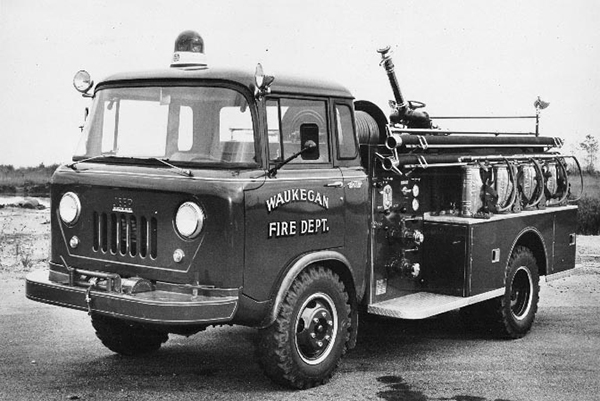
Rodger Birchfield collection

Rodger Birchfield collection
Tags: Chicago FD forward control Jeep history, Forward Control Jeeps in the fire service, Jeeep FC from the Waukegan Fire Department, Jeep FC170DRW, Martin Nowak, Palatine Rural FPD history, palatine Rural FPD Jeep FC170DRW, Rodger Birchfield, Waukegan Fire Department history
May 6
Posted by Admin in Fire Department History, Fire Truck photos, Historic fire apparatus, Historic Fire Photo | 6 Comments
Martin Nowak found this website The FC Connection, all about the life of the Jeep FC series (forward control). Among their historical postings are several units from the Chicago area. Click on each heading to see the original pages on the FC Connection site.
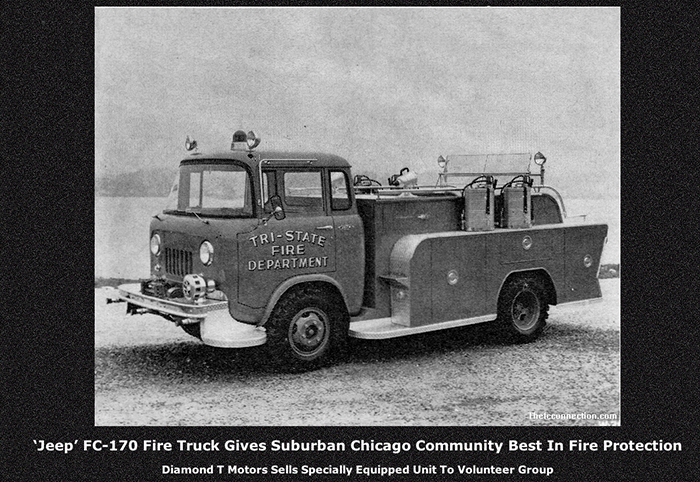
from the FC Connection.

from the FC Connection.
FC Jeeps in the Chicago Fire Department
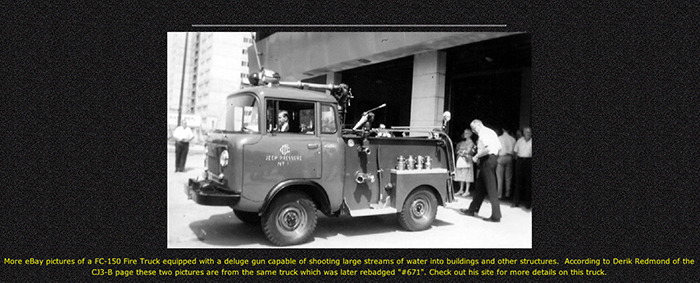
from the FC Connection.
More Chicago Fire Department FC Jeeps featured in Popular Science Magazine

from the FC Connection.
Waukegan Fire Department Forward Control Jeep engine

from the FC Connection.
Tags: Chicago FD forward control Jeep history, Chicago FD Jeep light wagon, Chicago Jeep Pressure Unit, Chicago Jeep Smoke Ejector, FC Connection, Forward Control Jeeps in the fire service, historic fire truck photos, Martin Nowak, Tri-State Fire Protection District, Waukegan Fire Department history

For the finest department portraits and composites contact Tim Olk or Larry Shapiro.
Arclite theme by digitalnature | powered by WordPress